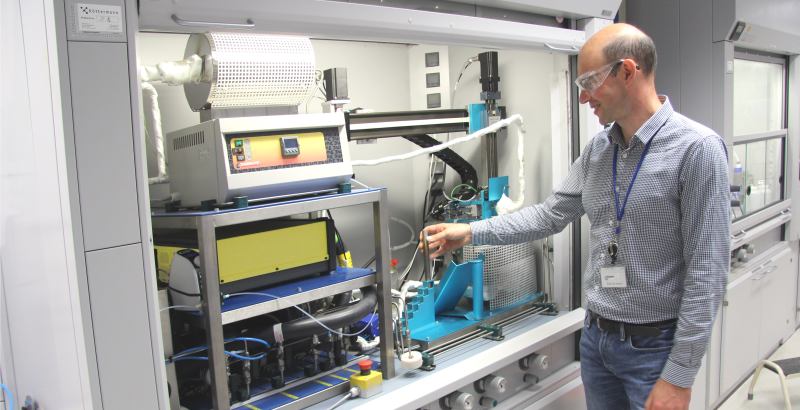
Sharing a common goal, experts in emissions monitoring and emissions abatement have formed a working partnership to develop innovative new materials for treating pollutants in flue gas emissions.
A business strategy with a heavy focus on innovation has enabled Lhoist to become one of the world’s leading providers of Flue Gas Treatment (FGT) products and solutions. In the following article, Johan Heiszwolf, Lhoist’s R&D Director for environmental applications and Antti Heikkilä from gas analyser manufacturer Gasmet Technologies explain how Lhoist’s continual investment in innovation has led to impressive growth in a variety of market sectors, including FGT.
Working closely with Gasmet’s Belgian Distributor, Kelma NV, Lhoist has developed laboratory, pilot scale and mobile process monitoring capabilities to evaluate FGT products that are still in the development phase or to demonstrate the effectiveness of existing FGT products at customers’ sites.
The FGT market has grown considerably in recent decades as a result of higher environmental standards and the development of regulations that imposed emissions limits on industrial processes. These regulations have also driven growth in Gasmet’s business as process operators around the world have sought to monitor multiple gases simultaneously with FTIR analysers for process control and to demonstrate compliance with emission limits.
One of the first product groups to be developed by the Lhoist BIC was Sorbacal® which is employed for the removal of major acid pollutants (SOx, HCl and HF) in gaseous emissions from combustion plants such as power stations and incinerators.
An enormous number of tests have to be undertaken to evaluate potential new products and in the case of FGT, the effectiveness of candidate products to remove pollutant gases is key. The BIC laboratory therefore developed a capability to generate artificial flue gas mixtures containing acid gases (SO2 and HCl) in a mixture of N2, O2, CO2, H2O and NOx.
Different gas analysers were initially used to measure different gases. "This complicated the work and incurred delays," comments Alain Brasseur, Lhoist FGT Senior Research Engineer. "A key advantage of FTIR is that it measures both SO2 and HCl, and does so without removing water from the sample."
A Gasmet DX4000 analyser is now deployed within the BIC laboratory and an automated system has been developed for running the tests unattended. As a result, the throughput of the laboratory was increased 10-fold. "The use of Gasmet FTIR gave us a greater insight into the characteristics of the sorbent and facilitated a major step forward in our development programme," comments Alain Brasseur. "By dramatically increasing the throughput we were able to evaluate a larger number of samples in a shorter period of time, which enabled us to discount those products that failed to meet the required levels of performance at an early stage."
The laboratory trials assess the intrinsic capacity of the sorbents and if they perform well, the assessment process is continued in a pilot plant to evaluate performance under simulated operating conditions. The pilot plant was also developed by the Lhoist BIC, and is capable of generating a mixture of aggressive gases and steam at 180 Deg C. The plant is also able to measure sorbent performance under dynamic conditions with varying gas concentrations and temperature.
The pilot plant consists of two separate units – each capable of generating dynamic emissions across a broad range of conditions. The emissions from the older of the two units are monitored with a Gasmet DX4000 heated multigas FTIR analyser. A new pilot unit is monitored by Gasmet’s fixed Continuous Emissions Monitoring System (CEMS) which analyzes gas both before and after treatment using a heated switch-over system.
In addition to the laboratory and pilot plant facilities, Lhoist has also developed a mobile system that is able to operate at customer sites.
FTIR (Fourier Transform InfraRed) is a sophisticated technology for analysing sample gases both qualitatively and quantitatively. The key feature of these instruments is their ability to monitor multiple compounds simultaneously. The Gasmet FTIR analysers are capable of measuring almost any gas and have been developed over many years specifically for the emissions monitoring market. This means that they are extremely rugged and work reliably in both fixed and portable versions.
All of the company’s FTIR instruments, fixed and portable, contain exactly the same core analyser which means that they can be operated with the same software, no extra training is necessary and results are directly comparable.
Using Calcmet™ software users of Gasmet analysers are able to analyse sample spectra, producing almost real-time data for pre-selected compounds. However, the retention of recorded spectra offers an opportunity to identify ‘unknowns’ by comparison with reference spectra, and to analyse recorded spectra retrospectively for compounds that were not necessarily of interest at the time of the measurement. This highlights an important advantage of FTIR – when it becomes necessary to measure new compounds, because of new legislation for example, no extra hardware is necessary, so the additional costs are negligible.
In contrast with many traditional gas analysers, the Gasmet FTIR instruments do not require periodic recalibration. A daily background spectrum measurement with zero gas (nitrogen) is enough to preserve measurement accuracy. Instead of periodic span calibrations, reference spectra for analysed gases are measured at the factory when the instrument is made and these do not drift.
From Lhoist’s perspective, Alain Brasseur says: "The ability to work with wet, corrosive gases is obviously a major advantage, and since we routinely analyse over 10 gases, monitoring is much less complicated now that we can do so with just one analyser.
"The size of the Gasmet analysers is also a major advantage for us – they fit neatly into the automated testing system which is installed in a normal lab fume cupboard, and the portable equipment is easy to transport to remote customer sites.
"We have found the instruments to be extremely reliable, requiring minimal maintenance. Also, the support from Gasmet and Kelma has been extremely good and the facility to connect to overseas instruments from Brussels via the internet has been a significant benefit."

